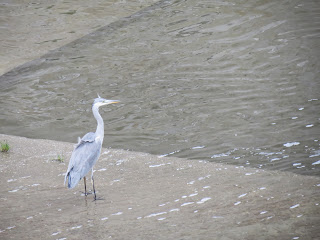In Venice, along with
feral pigeons, gulls are everywhere.
Black-headed gulls are the commonest, with
yellow-legged gulls also present. Further out in the countryside, you can also see
Mediterranean gulls and
slender-billed gulls. This post is a gallery of some of these gulls. First, let's have a little information on these gulls.
The
black-headed gull, Chroicocephalus ridibundus, is a small gull found in much of Eurasia, as well as coastal eastern Canada. In breeding plumage, the adult has a chocolate-brown coloured head (which can look black from a distance), a red bill and feet, a mostly white body and grey wings. In non-breeding plumage, the chocolate-brown hood is lost, with two dark spots on the head all that remains. This bold and opportunistic gull eats insects, fish, seeds, carrion, food scraps, invertebrates and worms, among others. Its call is a
kree-ar. It can live for up to 32.9 years in the wild.
The
yellow-legged gull, Larus michahellis, is another very common gull. It was formerly considered a subspecies of the Herring gull,
L. argentatus, or the Caspian gull,
L. cachinnans. There are two subspecies, with subspecies
michahellis in the Mediterranean area, including Venice. It is very common in Italy. Adults have slate-grey wings, a mostly white body and yellow legs, as well as a yellow bill with a red dot on the lower mandible. It has a red ring around its eye. Younger birds, or juveniles and immatures, are pale mottled brown. The call is a loud laugh deeper and more nasal than that of the herring gull. Like most
Larus gulls, it is omnivorous, eating pretty much whatever it can get its beak on.
The
Mediterranean gull, Ichthyaetus melanocephalus, is less common than the two gulls above. In breeding plumage, it can be distinguished from the
black-headed gull by its jet-black head and white eye crescents. In non-breeding plumage, instead of two dark spots it has a dusky-coloured 'bandit mask; through the eye. Once this bird was found only in the Black Sea and eastern Mediterranean, but it has now expanded over most of Europe, as far north as Ireland and Britain.
Now here are the pictures.
A black-headed gull, in non-breeding plumage
A flock of black-headed gulls in the Venetian countryside, all in non-breeding plumage
Another black-headed gull in non-breeding plumage
A swimming black-headed gull in non-breeding plumage
A black-headed gull, again in the Venetian countryside, also in non-breeding plumage
Here we have two different gulls. On the left, a black-headed gull in non-breeding plumage. On the right, an adult yellow-legged gull.
A closer view of that adult yellow-legged gull.
Another yellow-legged gull, this photo was taken from the deck of a water taxi
A subadult yellow-legged gull
A juvenile yellow-legged gull. Notice the difference?
A flock of yellow-legged gulls. Some are subadults, some are adults, some are juveniles.
A yellow-legged gull on the head of a winged lion statue, St. Mark's Square, Venice
Finally, a Mediterranean gull in non-breeding plumage.





















































